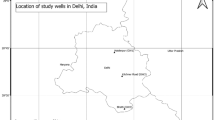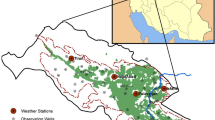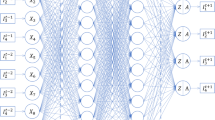Abstract
The shortage of surface water in arid and semiarid regions has led to the more use of the groundwater resources. In these areas, the groundwater is essential for activities such as water supply and irrigation. One of the most important stages in sustainable yield of groundwater resources is awareness of groundwater level. In this study, we have applied artificial neural networks (ANN) and autoregressive integrated moving average (ARIMA) models for groundwater level forecasting to 4 months ahead in Shiraz basin, southwestern Iran. Time series analysis was conducted according to the Box–Jenkins method. Meanwhile, gamma and M-test were considered for determining the optimal input combination and length of training and testing data in the ANN model. The results indicated that performance of multilayer perceptron neural network (4, 14, 1) and ARIMA (2, 1, 2) is satisfactory in the groundwater level forecasting for one month ahead. The performance comparison shows that the ARIMA model performs appreciably better than the ANN.





Similar content being viewed by others
References
Abghari H, Rezaeianzadeh M, Singh VP, Moradzadeh Azar F (2010) Comparison of monthly rainfall prediction using linear stochastic-base models in Gharalar rain gauge station Iran. Geophys Res Abstr 12, EGU2010-2652-1
Adhikary SK, Rahman MM, Gupta AD (2012) A stochastic modelling technique for predicting groundwater table fluctuations with time series analysis. Int J Appl Sci Eng Res 1(2):238–249
Aflatooni M, Mardaneh M (2011) Time series analysis of ground water table fluctuations due to temperature and rainfall change in Shiraz plain. Int J Water Resour Environ Eng 3(9):176–188
Agalbjörn S, Končar N, Jones AJ (1997) A note on the gamma test. Neural Comput Appl 53:131–133
Akaike H (1974) A look at the statistical model identification. IEEE Trans Autom Control AC 19:716–723
Banerjee P, Prasad RK, Singh VS (2009) Forecasting of groundwater level in hard rock region using artificial neural network. Environ Geol 58:1239–1246
Behzad M, Asghari K, Coppola EA (2010) Comparative study of SVMs and ANNs in aquifer water level prediction. J Comput Civ Eng 24(5):408–413
Bidwell VJ (2005) Realistic forecasting of groundwater level, based on the Eigenstructure of aquifer dynamics. Math Comput Simul 69:12–20
Boochabun K, Tych W, Chappell NA, Carling PA, Lorsirirat K, PaObsaeng S (2004) Statistical modelling of rainfall and river flow in Thailand. J Geol Soc India 64:503–515
Box GEP, Jenkins GM (1970) Time series analysis: forecasting and control. Holden-Day, San Francisco
Chattopadhyay S, Chattopadhyay G (2010) Univariate modeling of summer-monsoon rainfall time series: comparison between ARIMA and ARNN. CR Geosci 342:100–107
Chattopadhyay S, Jhajharia D, Chattopadhyay G (2011) Univariate modelling of monthly maximum temperature time series over northeast India: neural network versus Yule–Walker equation based approach. Meteorol Appl 18:70–82
Choubin B, Khalighi-Sigaroodi S, Malekian A, Ahmad S, Attarod P (2014) Drought forecasting in a semi-arid watershed using climate signals: a neuro-fuzzy modeling approach. J Mt Sci 11(6):1593–1605. doi:10.1007/s11629-014-3020-6
Choubin B, Khalighi-Sigaroodi S, Malekian A, Kişi Ö (2016a) Multiple linear regression, multi-layer perceptron network and adaptive neuro-fuzzy inference system for forecasting precipitation based on large-scale climate signals. Hydrol Sci J 61(6):1001–1009. doi:10.1080/02626667.2014.966721
Choubin B, Malekian A, Golshan M (2016b) Application of several data-driven techniques to predict a standardized precipitation index. Atmósfera 29(2):121–128. doi:10.20937/ATM.2016.29.02.02
Choubin B, Malekian A, Samadi S, Khalighi‐Sigaroodi S, Sajedi-Hosseini F (2017a) An ensemble forecast of semi-arid rainfall using large-scale climate predictors. Meteorol Appl. doi:10.1002/met.1635
Choubin B, Solaimani K, Habibnejad Roshan M, Malekian A (2017b) Watershed classification using remote sensing indices: a fuzzy c–means clustering approach. J Mt Sci. doi:10.1007/s11629-017-4357-4
Coulibaly P, Anctil F, Aravena R, Bobee B (2001) Artificial neural network modeling of water table depth fluctuations. Water Resour Res 37(4):885–896
Daliakopoulos IN, Coulibaly P, Tsanis IK (2005) Groundwater level forecasting using artificial neural networks. J Hydrol 309(1–4):229–240
Dash NB, Panda SN, Ramesan R, Sahoo N (2010) Hybrid neural modeling for groundwater level prediction. Neural Comput Appl 19(8):1253–1261
Dickey DA, Fuller WA (1979) Estimators for autoregressive time series with a unit root. J Am Stat Assoc 74:427–431
Durrant PJ (2001) WinGamma: a non-linear data analysis and modeling tool with applications to flood prediction. Ph.D. thesis, Department of Computer Science, Cardiff University, Wales, UK
Evans D, Jones AJ (2002) A proof of the gamma test. Proc R Soc Ser A 458:2759–2799
Han D, Yan W, Moghaddamnia A (2010) Uncertainty with the gamma test for model input data selection. In: WCCI 2010 IEEE world congress on computational intelligence. July 18–23, 2010—CCIB, Barcelona, Spain, pp 1–5
Hintze JL, Nelson RD (1998) Violin plots: a box plot-density trace synergism. Am Stat 52(2):181–184
Hsu KL, Gupta HV, Sorooshian S (1955) Artificial neural network modeling of rainfall-runoff process. Water Resour Res 31(10):2517–2530
Huang GB, Zhu QY, Siew CK (2006) Extreme learning machine: theory and applications. Neurocomputing 70:489–501
Jajarmizadeh M, Kakaei Lafdani E, Harun S, Ahmadi A (2015) Application of SVM and SWAT models for monthly streamflow prediction, a case study in South of Iran. KSCE J Civ Eng 19(1):345–357
Kim T, Valdés J (2003) Nonlinear model for drought forecasting based on a conjunction of wavelet transforms and neural networks. J Hydrol Eng 8(6):319–328
Končar N (1997) Optimisation methodologies for direct inverse neurocontrol. Ph.D. thesis, Deptartment of Computing, Imperial College of Science, Technology and Medicine, University of London, London
Kakaei Lafdani E, Nia AM, Ahmadi A (2013) Daily suspended sediment load prediction using artificial neural networks and support vector machines. J Hydrol 478:50–62
Lee SI, Lee SK, Hamm SY (2009) A model for groundwater time-series from the well field of riverbank filtration. J Korea Water Resour Assoc 42:673–680
Lin GF, Chen LH (2005) Time series forecasting by combining the radial basis function network and the self-organizing map. Hydrol Process 19(10):1925–1937
Lu WX, Zhao Y, Chu HB, Yang LL (2013) The analysis of groundwater levels influenced by dual factors in western Jilin Province by using time series analysis method. Appl Water Sci 4(3):251–260
Moghaddamnia A, Ghafari Gousheh M, Piri J, Amin S, Han D (2009a) Evaporation estimation using artificial neural networks and adaptive neurofuzzy inference system techniques. Adv Water Resour 32(1):88–97
Moghaddamnia A, Ghafari M, Piri J, Han D (2008) Evaporation estimation using support vector machines technique. Proc World Acad Sci Eng Technol 33:14–22
Moghaddamnia A, Ghafari M, Piri J, Han D (2009b) Evaporation estimation using support vector machines. Int J Eng Phys Sci 3(3):134–142
Moghaddamnia A, Remesan R, Hassanpour Kashani M, Mohammadi M, Han D, Piri J (2009c) Comparison of LLR, MLP, Elman, NNARX and ANFIS models with a case study in solar radiation estimation. J Atmos Solar Terr Phys 71:975–982
Narayanan P, Basistha A, Sarkar S, Kamna S (2013) Trend analysis and ARIMA modelling of pre-monsoon rainfall data for western India. CR Geosci 345(1):22–27
Nayak PC, Rao YRS, Sudheer KP (2006) Groundwater level forecasting in a shallow aquifer using artificial neural network approach. Water Resour Manag 20(1):77–90
Noori R, Karbassi AR, Sabahi MS (2010) Evaluation of PCA and Gamma test techniques on ANN operation for weekly solid waste predicting. J Environ Manag 91:767–771
Nourani V, Ejlali RG, Alami MT (2011) Spatiotemporal groundwater level forecasting in coastal aquifers by hybrid artificial neural network-geostatistics model: a case study. Environ Eng Sci 28(3):217–228
Nourani V, Mogaddam AA, Nadiri AO (2008) An ANN-based model for spatiotemporal groundwater level forecasting. Hydrol Process 22(26):5054–5066
Phillips PCB, Perron P (1988) Testing for a unit root in time series regression. Biometrika 75:335–346
Piri J, Amin S, Moghaddamnia A, Keshavarz A, Han D, Remesan R (2009) Daily pan evaporation modeling in a hot and dry climate. J Hydrol Eng 14(8):803–811
Rashidi S, Vafakhah M, Kakaei Lafdani E, Javadi MR (2016) Evaluating the support vector machine for suspended sediment load forecasting based on gamma test. Arab J Geosci 9(11):583
Remesan R, Shamim MA, Han D (2008) Model data selection using Gamma test for daily solar radiation estimation. Hydrol Process 22(21):4301–4309
Schwarz G (1978) Estimating the dimension of a model. Ann Stat 6(2):461–464
Sethi RR, Kumar A, Sharma SP, Verma HC (2010) Prediction of water table depth in a hard rock basin by using artificial neural network. Int J Water Resour Environ Eng 2(4):95–102
Shamim MA, Hassan M, Ahmad S, Zeeshan M (2016) A comparison of artificial neural networks (ANN) and local linear regression (LLR) techniques for predicting monthly reservoir levels. KSCE J Civ Eng 20(2):971–977
Shirmohammadi B, Vafakhah M, Moosavi V, Moghaddamnia A (2013) Application of several data-driven techniques for predicting groundwater level. Water Resour Manag 27(2):419–432
Sigaroodi SK, Chen Q, Ebrahimi S, Nazari A, Choobin B (2014) Long-term precipitation forecast for drought relief using atmospheric circulation factors: a study on the Maharloo Basin in Iran. Hydrol Earth Syst Sci 18(5):1995–2006. doi:10.5194/hess-18-1995-2014
Singh S (2005) Implementation of the Gamma test in MATLAB using a fast near algorithm in C++. Dissertation, Department of Computer Science, Cardiff University
Stefansson A, Koncar N, Jones AJ (1997) A note on the gamma test. Neural Comput Appl 5:131–133
Trichakis IC, Nikolos IK, Karatzas GP (2009) Optimal selection of artificial neural network parameters for the prediction of a karstic aquifer’s response. Hydrol Process 23(20):2956–2969
Tsanis IK, Coulibaly P, Daliakopoulos IN (2008) Improving groundwater level forecasting with a feedforward neural network and linearly regressed projected precipitation. J Hydroinf 10(4):317–330
Tsui APM, Jones AJ, De Oliveira AG (2002) The construction of smooth models using irregular embeddings determined by a gamma test analysis. Neural Comput Appl 10(4):318–329
Voudouris K (2002) Time series analysis using ARIMA models of the groundwater table in Patras industrial area aquifer system NW Peloponnese, Greece. Terra Nostra (Bonn) 3:335–340
Yang ZP, Lu WX, Long YQ, Li P (2009) Application and comparison of two prediction models for groundwater levels: a case study in Western Jilin Province, China. J Arid Environ 73:487–492
Yurekli K, Simsek H, Cemek B, Karaman S (2007) Simulating climatic variables by using stochastic approach. Build Environ 42:3493–3499
Zakaria S, Al-Ansari N, Knutsson S, Al-Badrany T (2012) ARIMA Models for weekly rainfall in the semi-arid Sinjar District at Iraq. J Earth Sci Geotech Eng 2(3):25–55
Author information
Authors and Affiliations
Corresponding author
Rights and permissions
About this article
Cite this article
Choubin, B., Malekian, A. Combined gamma and M-test-based ANN and ARIMA models for groundwater fluctuation forecasting in semiarid regions. Environ Earth Sci 76, 538 (2017). https://doi.org/10.1007/s12665-017-6870-8
Received:
Accepted:
Published:
DOI: https://doi.org/10.1007/s12665-017-6870-8




